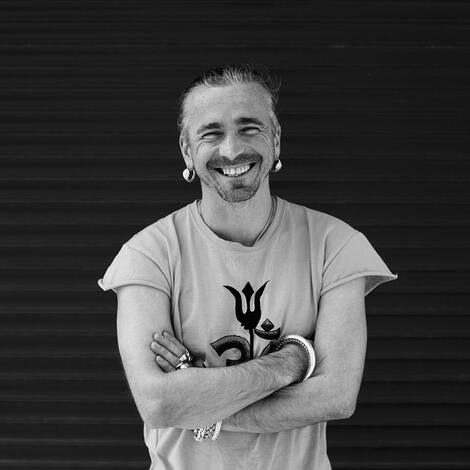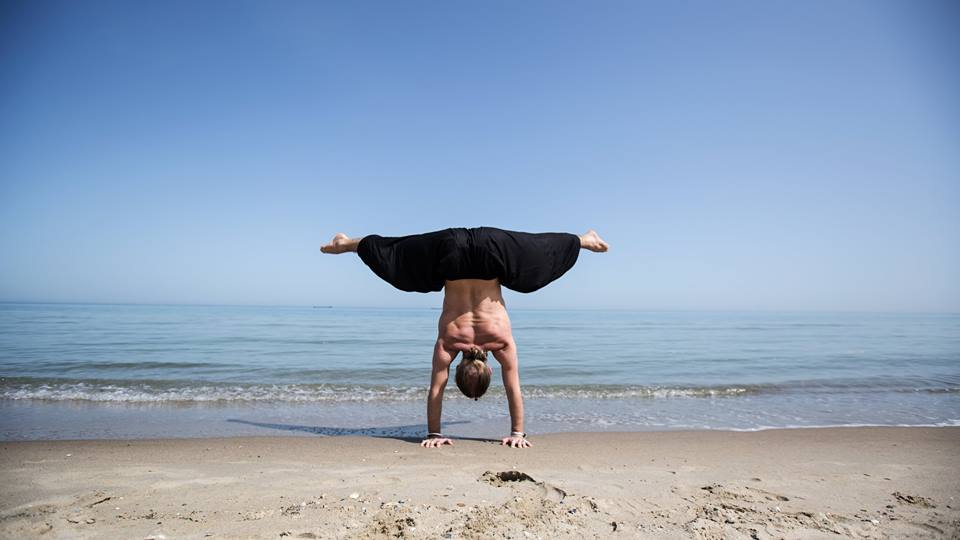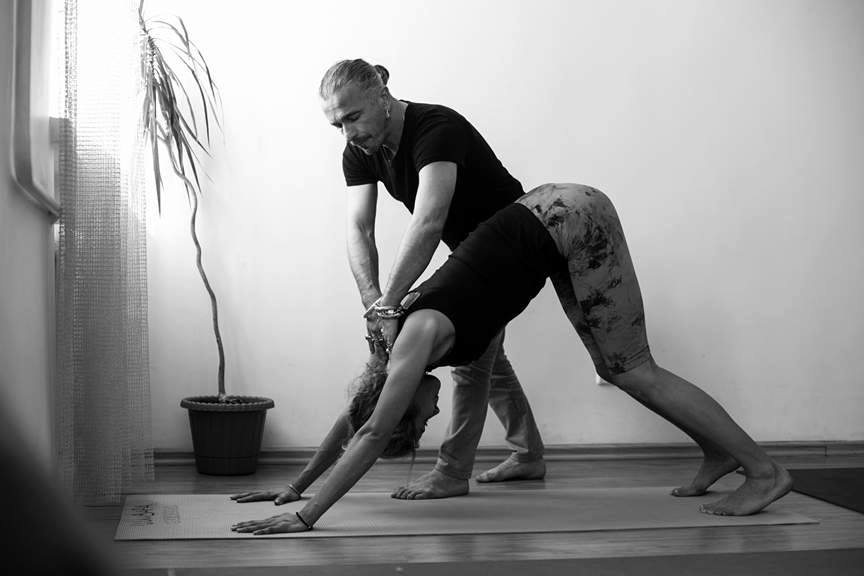Interview with Anatoliy Zenchenko: The purpose of yoga is not to put your foot behind your head. It’s to learn to feel yourself.

Anatoliy Zenchenko, the founder of Ishvara yoga style, has shared with TopYogis his thoughts on Ishvara yoga, headstands, signs of progress in yoga, and reasons why we try to put the leg behind the head.
TopYogis: Anatoliy, tell us, what is the goal of yoga for you?
Anatoliy Zenchenko: It’s hard to say. Perhaps, it helps me to become more wholesome and content. That’s why I can say that I’m terribly selfish, I practice yoga to achieve happiness.
TopYogis: And you help your students in the class to achieve the same?
Anatoliy Zenchenko: Yes, I want them to have everything, and pay nothing for it. In other words, I want them to be able to do anything without experiencing pain.
TopYogis: You have developed your own system, Ishvara yoga. What is its difference from usual hatha yoga?
Anatoliy Zenchenko: What we call hatha yoga nowadays is the type of yoga focused on body work. All the styles that we see are systems developed by some teachers - Iyengar yoga, Ashtanga vinyasa, Bikram - it’s their interpretation of what techniques and approaches to body work will yield results of yoga. Ishvara yoga is one of such systems. That is to say, Ishvara is one of the schools of hatha yoga.
This style has two distinctive features. First is internal principles of body work. They are universal, and there are 10 of them. These principles respond to the question “why you cannot perform a particular asana, and what you need to do to to correct the problem”. These principles provide an understanding of how to do asanas correctly. But look, in modern yoga, there are styles focused on alignment in asanas. What is the approach of those styles? If we want to have good alignment in Utthita Trikonasana, we need to do 387 adjustments. And if we want to perform Parivrita Trikonasana, we need to do 456 adjustments, but completely different ones. And in Ishvara yoga, we have just 10 principles. And they are applied to any asana. I bend forward and I implement these 10 principles. I do backward bend, and I use the same 10 principles. This can sound like a paradox, but to perform forward bend and backward bend, internally I need to do the same things.
I will briefly explain. There are two things that prevent us from performing any asana. The first one is the disconnection of the body. That means, a person perceives his or her body as a collection of separate parts.
TopYogis: Like a leg, an arm..
Anatoliy Zenchenko: Yes. And when you start doing asana, your body is afraid that you will break down, that all these legs and arms will fly to different directions. The body is afraid that you will break it, and therefore it protects itself. With a tension. And what do you do in response? You stretch it. Whoever wins this game, there is no winner. Because everybody thinks that the coolest thing is to conquer oneself, but I think it is an idiotic thing, to fight with oneself. Because, having conquered oneself, who is the conqueror, the winner?
The second reason of why we cannot perform any asana is the absence of coherent muscle work. Muscles should work together synergistically, to be connected in chains. And very often we create problems for ourselves because we cannot create what I call a synergistic work of motor muscles. So the first five principles of inner work explain how to remove disconnection in the body, while the other five outline how to create a synergistic muscle work.
There are two things that prevent us from performing any asana. The first one is the disconnection of the body. That means, a person perceives his or her body as a collection of separate parts. And when you start doing asana, your body is afraid that you will break down, that all these legs and arms will fly to different directions. The body is afraid that you will break it, and therefore it protects itself. With a tension. And what do you do in response? You stretch it. Whoever wins this game, there is no winner. The second reason of why we cannot perform any asana is the absence of coherent muscle work.
 This is the first distinctive feature of Ishvara yoga. The second one is the methodology. It’s about how to build a teaching process from simple things to more complex ones so that we could develop harmoniously and progress from simple elements to some more complicated stuff. This teaching process should also take into account individual features of people, their problems and aches, the state of their spine and so forth. The methodology is based on the principles of building training sequences. These principles rely on the detailed classification of asanas. That is to say, I understand, how asanas work together, how they complement each other, how they can be simplified of intensified, what parts of the body they work with, and so on.
This is the first distinctive feature of Ishvara yoga. The second one is the methodology. It’s about how to build a teaching process from simple things to more complex ones so that we could develop harmoniously and progress from simple elements to some more complicated stuff. This teaching process should also take into account individual features of people, their problems and aches, the state of their spine and so forth. The methodology is based on the principles of building training sequences. These principles rely on the detailed classification of asanas. That is to say, I understand, how asanas work together, how they complement each other, how they can be simplified of intensified, what parts of the body they work with, and so on.
TopYogis: Does that mean that you don’t teach your instructors a set of sequences, but rather principles of how to develop their own sequences?
Anatoliy Zenchenko: Yes. They are programmers, and if they understand the programming language, they do what they need to do in accordance with the level of the group, time of year, tasks of training and so on.
TopYogis: Tell us Anatoliy, if a person has only 15 minutes a day to practice yoga, which is the most important practice you would recommend to do?
Anatoliy Zenchenko: Well, everyone has their own things to work on. But if one has only 15 minutes, I would say, abdominal work: uddiyana bandha, agni-sara, nauli. But if everything is so sad that one has only 15 minutes for yoga, I think one should not even do the abdominal work but devote this time to reflection: what rubbish am I doing the rest of the day that prevents me from practicing yoga? And stop doing it.
TopYogis: Well, let’s say, a person can come to you classes on Monday and Thursday, but also wants to practice on his own the rest of the days.
Anatoliy Zenchenko: Well, let’s take then every day, one hour minimum. I know that the most popular book on yoga is titled “5 minutes of yoga in bed”. And you want to drag me in the same direction. No, I refuse (laughs).
TopYogis: What do you think about headstand?
Anatoliy Zenchenko: I don’t think about it, I do it.
TopYogis: Well, do you think that some people may not be fit to do it? Or maybe that this practice is injury-prone.
 Anatoliy Zenchenko: Well, the way I stand on the head is different from the way everybody is doing it. Everybody is standing on their forehead and bend their lumbar, performing what I call “bananasana”. I stand on the top of my head and I almost don’t have any weight on my head, because the weight is in my arms. Headstand is a wonderful asana, but to perform it correctly, you need to be prepared. For example, today you were preparing for a headstand with the dolphin dynamic exercise. If someone comes to my class and they are really weak, I will not ask them to do a headstand. They would do exercises to increase strength in shoulders, arms, and neck.
Anatoliy Zenchenko: Well, the way I stand on the head is different from the way everybody is doing it. Everybody is standing on their forehead and bend their lumbar, performing what I call “bananasana”. I stand on the top of my head and I almost don’t have any weight on my head, because the weight is in my arms. Headstand is a wonderful asana, but to perform it correctly, you need to be prepared. For example, today you were preparing for a headstand with the dolphin dynamic exercise. If someone comes to my class and they are really weak, I will not ask them to do a headstand. They would do exercises to increase strength in shoulders, arms, and neck.
TopYogis: Can you tell people’s progress in yoga by the way they perform asanas?
Anatoliy Zenchenko: Certainly. We have two criteria of good practice: internal and external. Internal criterion is the main one. It’s like this: you perform an asana and you should feel good in it. And the teacher can tell who feels good, and who does not. The external criterion is very simple: either you do an asana, or you don’t. Either you can put the foot behind your head, or you cannot. But if you can, you need to feel good.
TopYogis: And what do you say to a student, who wants to perform a challenging asana, and you see that he does not feel good in it?
Anatoliy Zenchenko: I explain to him what will happen to his lumbar and other body parts if he pushes things. And I tell him: “My dear, you are now doing this asana - yes. Do you feel pain? Yes, you do. Why? Let’s make everything properly, and you will feel good”. I explain to him, that if he puts the foot behind his head now, he will not receive a raise, he will not receive a medal of a hero, nor a free ride in the bus. You need to feel good. You need to understand, what prevents you from putting your foot behind the head, find it inside of you, and restore the integrity in the places that lack it. And the foot will get behind your head automatically.
We have two criteria of good practice: internal and external. Internal criterion is the main one. It’s like this: you perform an asana and you should feel good in it.
What I mean, the problem is, you do not feel yourself. And the goal of yoga is not to put your foot behind your head. It’s to learn to feel yourself. Understand where you feel good, and where you feel bad. Understand why you feel bad and what you need to do to improve. The purpose of yoga is for us to learn to feel ourselves, understand ourselves, accept ourselves, love ourselves if you will. You need to feel good. Without pain.
The goal of yoga is not to put your foot behind your head. It’s to learn to feel yourself. Understand where you feel good, and where you feel bad. Understand why you feel bad and what you need to do to improve.
If you have practiced with Anatoliy Zenchenko, please share your experience by leaving a review on his personal page or the page of his school.
Find Ishvara yoga instructors around the world.
Find yoga teachers in Kiev (all styles)
If you're a yoga teacher, create your profile page on TopYogis. Here's what it can give you.
